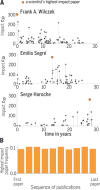Science of science
- PMID: 29496846
- PMCID: PMC5949209
- DOI: 10.1126/science.aao0185
Science of science
Abstract
Identifying fundamental drivers of science and developing predictive models to capture its evolution are instrumental for the design of policies that can improve the scientific enterprise-for example, through enhanced career paths for scientists, better performance evaluation for organizations hosting research, discovery of novel effective funding vehicles, and even identification of promising regions along the scientific frontier. The science of science uses large-scale data on the production of science to search for universal and domain-specific patterns. Here, we review recent developments in this transdisciplinary field.
Copyright © 2018 The Authors, some rights reserved; exclusive licensee American Association for the Advancement of Science. No claim to original U.S. Government Works.
Figures





Comment in
-
Science looks worse because it's getting better.Nature. 2019 Mar;567(7748):311. doi: 10.1038/d41586-019-00928-x. Nature. 2019. PMID: 30890805 No abstract available.
References
-
- Price DJS. Little Science, Big Science. Columbia Univ Press; 1963.
-
- Foster JG, Rzhetsky A, Evans JA. Tradition and innovation in scientists’ research strategies. Am Sociol Rev. 2015;80:875–908. doi: 10.1177/0003122415601618. - DOI
-
- Milojević S. Quantifying the cognitive extent of science. J Informetr. 2015;9:962–973. doi: 10.1016/j.joi.2015.10.005. - DOI
-
- Kuhn T, Perc M, Helbing D. Inheritance patterns in citation networks reveal scientific memes. Phys Rev X. 2014;4:041036. doi: 10.1103/PhysRevX.4.041036. - DOI
Publication types
Grants and funding
LinkOut - more resources
Full Text Sources
Other Literature Sources

